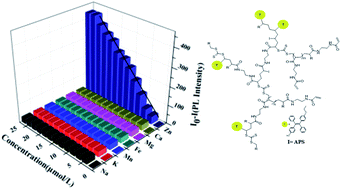Facile construction of a hyperbranched poly(acrylamide) bearing tetraphenylethene units: a novel fluorescence probe with a highly selective and sensitive response to Zn2+†
Abstract
Thermo-responsive hyperbranched copoly(bis(N,N-ethyl acrylamide)/(N,N-methylene bisacrylamide)) (HPEAM-MBA) was synthesized by using reversible addition–fragmentation chain-transfer polymerization (RAFT). Interestingly, the zinc ion (Zn2+) was found to have a crucial influence on the lowest critical solution temperature (LCST) of the thermo-responsive polymer. The tetraphenylethylene (TPE) unit was then introduced onto the backbone of the as-prepared thermo-responsive polymer, which endows a Zn2+-responsive “turn-off” effect on the fluorescence properties. The TPE-bearing polymer shows a highly specific response over other metal ions and the “turn-off” response can even be tracked as the concentration of Zn2+ reduces to 2 × 10−5 M. The decrement of fluorescence intensity was linearly dependent on the concentration of Zn2+ in the range of 4–18 μmol L−1. The flexible, versatile and feasible approach, as well as the excellent detection performance, may generate a new type of Zn2+ probe without the tedious synthesis of the moiety bearing Zn2+ recognition units.



 Please wait while we load your content...
Please wait while we load your content...